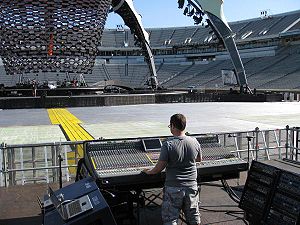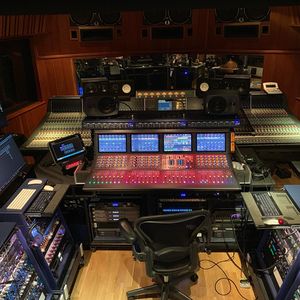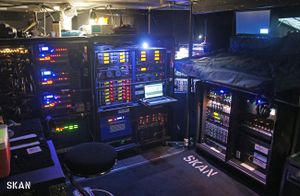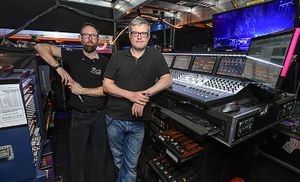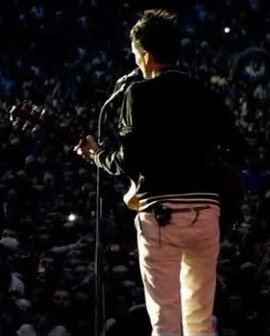Difference between revisions of "Other gear"
(→Percussion: Removed llama toenails as they're already listed on the "Percussion" page) |
|||
| Line 116: | Line 116: | ||
Two large concert bass drums were played by both Wolstenholme and Howard during the 2019 [[Simulation Theory World Tour]], used for [[Pray (Matthew Bellamy song)|Pray]]. This can be seen and heard [https://youtu.be/LqWDWn3mTF4 here]. | Two large concert bass drums were played by both Wolstenholme and Howard during the 2019 [[Simulation Theory World Tour]], used for [[Pray (Matthew Bellamy song)|Pray]]. This can be seen and heard [https://youtu.be/LqWDWn3mTF4 here]. | ||
=== | === Stomps, claps & snaps === | ||
A fairly common (and accessible) percussion element throughout music, used quite a lot in Muse's songs, with usually all three of them recording in the same room. Heard most notably in songs such as [[Intro (song)|Intro]] and [[Apocalypse Please (song)|Apocalypse Please]], [[Time Is Running Out (song)|Time Is Running Out]], [[Uprising (song)|Uprising]], [[I Belong To You (song)|I Belong To You]], [[Survival (song)|Survival]] and [[Pressure (song)|Pressure]]. | |||
=== Cardboard boxes with an aluminium chair === | |||
These, seemingly everyday objects, were used by Matt Bellamy in the studio, while recording Drones, throwing them around the big reverby live room of [[London AIR Studios|London's AIR Studios]] and covering them in more reverb. The final sounds gave a thunderclap effect to the intro of [[The Globalist (song)|The Globalist]]. | |||
== References == | |||
<references/> | |||
== Harmonica == | == Harmonica == | ||
Revision as of 01:46, 17 February 2022
Backing tracks and click tracks
Backing tracks Muse make increasing use of backing tracks when performing live. A "backing track" is a recorded track that the band play along to, in order to add extra layers to their music, which cannot be played by only three people. This includes, for example, the orchestral strings in songs like Butterflies & Hurricanes and Unsustainable, the synthesizer arpeggios in Bliss and Starlight, the "I Want It Now" backing vocals in "Hysteria" and the speech in Psycho. The tracks are usually played through an off-stage computer, together with a click-track. For the Origin of Symmetry era and (especially) the Absolution era, the band had to rely solely on backing tracks for additional instrumentation. Since Black Holes & Revelations, the band hired Morgan Nicholls to help with additional instrumentation on most of the songs, cutting the need for more backing tracks, while also making the songs performed live sound a lot closer to their studio versions.
Click tracks Because backing tracks are in a set tempo, the band have to keep time with them. To do that, the entire band use a digital metronome (also known as a "click track") – synchronised to the recording – playing through their In-Ear Monitors, which the audience do not hear. A click track is also used in some songs which do not have backing tracks in order to keep in time with synchronised guitar effects like delays, for example in "Sing For Absolution". During Map of the Problematique, Unsustainable, and the solos of Reapers and Thought Contagion, Matt's Whammy pedal is also synchronised to the click track via MIDI, allowing Matt to walk around on stage freely, instead of controlling the Whammy pedal. It also eliminates the need for Matt's guitar tech to do all the Whammy controlling.
FOH console and rack
Muse's sound engineer (also known as a "Front of House/FOH" engineer), Marc Carolan has been in charge of their live sound ever since the Origin of Symmetry era in 2001. Ever since then, up until 2018, he has been using a Midas XL4 console as his main console. Occasionally, he has also used a Midas PRO6, as well as a Midas Pro 2C sidecar console, which he has coupled with the XL4. In 2018, he ditched the Midas XL4 from his live setup and upgraded to a digital system, using a smaller Avid Venue S6L 32D digital console, coupled with Midas's XL48 preamps in three rack units, sitting atop of the S6L (used for drums/bass/guitars/vocals), allowing him to keep the "Midas" sound/colour. With the Avid console though, he is able to switch between the XL48 and the Avid preamps. In terms of inputs, Muse ran a total of 112 inputs to the mixing board for the Simulation Theory tour in particular.
With using outboard gear since starting out with Muse in 2001, he is familiar with the gear and the colour it brings to the sound, and is thus still using racks, despite upgrading to a digital console. His racks have been filled with the following gear for the recent Simulation Theory tour:
- Tube-Tech SMC-2B multiband compressor
- Midas XL42 preamps
- GML 8200 EQ on the main L/R bus
- Rupert Neve Designs 5059 16-channel summing mixer (using 2x mono + 7x stereo)
- Dbx 160s on kick and floor toms
- SPL Transient Designer for toms, kick and snare
- Empirical Labs UBK-modded Fatso and Mäag Audio EQ4 for "kit stem" (anything that is not a kick and snare)
- Tube-Tech LCA-2B on bass and guitars
- Avalon VT-737 for overdriven vocals
- Empirical Labs EL8 Distressor for vocals
- Eventide H3000 D/SE for vocal processing
- Line 6 Echo Pro for vocal delays
- Bricasti M7 for vocal and tom reverbs
- Yamaha SPX2000s for snare reverb (on plate), vocal doubling and distortions
- Empirical Labs EL8 Distressors and BSS Audio 901II multiband compressors for vocals and various other elements (Carolan reffers to the latter as his swiss army knife)
As far as digital plug-ins go (used through the Avid console itself), he has listed the following:
- Avid Pro Subharmonic (replaced the Dbx 120 subharmonic synth rack unit) for drums
- Sonnox Oxford Dynamics on overheads
- McDSP AE600 Active EQ on bass guitars' distortion channels and vocals (replaced the BSS DPR-901 dynamic eqalizer)
- Empirical Labs Arousor on drum pads and acoustic guitars
- Sonnox De-Esser on acoustic guitars
- Avid Pro Multiband for guitars (mostly D.I. signal) and backing tracks
- McDSP EC-300 (replaced the Line 6 Echo Pro rack unit) (Analog Delay for vocals and Magnetic Delay for backing vocals)
- Waves CLA-2A on vocals
Additionally, he's also been seen using the Genelec 8020 reference monitors, at rehearsals only.
For a more in-depth tour of Carolan's set-up, click this link for a series of videos on mixing Muse live, posted on Avid's YouTube channel, or this link for an in-depth interview for Drew Thornton's (Billie Eilish, Finneas) podcast "A Sum Of Two Busses".
Monitors
In-ear monitors & monitoring
The whole purpose of In-Ear Monitoring is to reduce outside noise so that the artist can listen to the mix and hear what he is playing at comfortable levels, thus saving his/her hearing. As each set of In-Ear Monitors (IEMs) is custom made to fit the artist's ear perfectly, over 20dB of isolation is given. As noted above, IEMs are also used to provide the band with a click track. The use of IEM monitors also eliminates the need to use on-stage, so called "wedge" speakers. One drawback to having IEMs however, with Muse's setup in particular is, that, due to the lack of on-stage speakers, you don't get the low-end rumble and the vibrations, which is why Chris and Dom require additional subwoofers to "feel" the low end on-stage.
Muse started out with using Shure E5 In-Ear-Monitors (IEMs) since around 2003/2004, before switching to Westone's UM2 IEMs in 2010, with Morgan Nicholls using the Ultimate Ears UE7.[1]. During the last tours, they have upgraded from Westone's UM2 to UM3 IEMs for all the band, including Morgan. According to their monitor engineer, they have tried every make and model of custom IEMs, however the generic Westone IEMs always work for them, as they are lightweight, easily replacable and provide lots of consistent isolation.
The wireless IEM transmitters used to be Sennheiser G3 300.[2] During The 2nd Law tour, these have been upgraded to the Senheiser 2000 transmitters. [3] Additionally, Dominic has two L-Acoustics dV-SUB subwoofers[4] sitting behind him to add more low end to his monitoring needs. and Chris has two d&b J-SUBs for the same reason.[5][6]
Monitor console and rack
Muse's monitor engineer, Adam Taylor, used to use a Digidesign Profile mixing desk for automation, delay & reverb purposes, and a Midas Heritage 3000 as his main console. For The Resistance tour, he upgraded to a Midas Pro 9 mixing console, which he has been using until 2019. As of the Simulation Theory World Tour in 2019, he upgraded to an Avid S6L platform. This makes both Carolan and Taylor sit on the same platform, which, for the first time, is not a Midas-based platform, with three shared Stage 64, 128-Channel Mac Pro dual record systems. According to Taylor, there was an option to upgrade to Midas's Pro X platform, however at the end, Avid's S6L was a better choice.
Plug-In wise, Taylor is using Sonnox EQ and Dynamics, McDSP's Channel G and EQ, and other S6L's standard live-bundle plugins. Hardware wise, he is currently using the GML 8200 EQ for IEM outputs, four Little Labs Phase Allignment units and an Aphex Dominator II over the main IEM mixes.
PA System
Before The Resistance world tour, Muse used an L-Acoustics V-Dosc system. As of The Resistance tour, Marc Carolan's PA system of choice are d&b Audiotechnik speakers. For The Resistance tour, Muse used the J-Series speakers.[7]. Additionally, for the Drones 360 tour, with the stage being in the centre, they were using d&b's array processing, allowing them to have an even coverage along the entire venue. All PA is provided to Muse by their long-time PA hire company called "Skan PA Hire", based in Newbury, England.
For the Simulation Theory Tour's outdoor gigs, they were using the following d&b PA set up[8]:
- Main hangs: 44 d&b GSL line arrays (22 per hang)
- Side hangs: 40 d&b GSL line arrays (20 per hang)
- Delay hangs: 32 d&b GSL line arrays (16 per hang)
- 220˚ hangs: 22 d&b KSL line arrays (12 per hang)
- Ring delay hangs: 60 d&b KSL line arrays (6 per hang)
- Subs: 25 d&b SL-sub subwoofers
- Front fills: 12 d&b J12 & Y10P loudspeakers
- Amplifiers: d&b D80 (connected over redundant fibre networks)
- A/D Conversion: Apogee Rosetta 800
- System Processor: Lake LM-44, Cisco based fibre dual ring system, Teqsas cyberteq distribution system, Dante AVIO adapters and Unifi Mesh Pro WiFi System
- Back Up System: Avid 24C and E6L 192
- Support Package: 2 aAvid S6L 24C 112 Engines Shared I/O systems
- Intercom System: Green-GO Digital Communication Systems with over 30 wired and wireless comms
For the tour's indoor gigs, the setup was similar, but with less speakers. The setup was as listed[9]:
- Main hangs: 36 d&b GSL line arrays (18 per hang)
- Side hangs: 32 d&b GSL line arrays (16 per hang)
- 220˚ hangs: 12 d&b KSL line arrays
- Subs: 17 d&b SL-sub subwoofers
- Front fills: 8 d&b Y10P (main stage) & 2 d&b Y10P (B-stage)
Other specs are the same as with the stadium shows.
Plectrum
Main article: Plectrums
Percussion
This section only lists percussion used by Chris Wolstenholme and Morgan Nicholls. For percussion used by Howard, see the main article
Maraca
A "maraca", also called a "rumba shaker" or a "chac-chac", due to it's distinct sound, is a shaker (or, specifically, a rattle), appearing mainly in Latin and Carribean music. It's distinct shape allows it to be shaken by holding a handle, attached (often in one piece) to a hollow "belly" containing either dried beans, beads, pebbles or other similar materials. Maracas are traditionally made out of wood, but plastic or leather maracas can also be found.
Live, two maracas were used by Christopher Wolstenholme for the verse of "Endlessly" during the Absolution Tour. This can also be seen (and heard) in this clip of Muse performing Endlessly live.
Cabasa
A "cabasa" is a percussion instrument, constructed with loops of steel ball chain, wrapped around a cylinder, attached to a wooden or plastic handle. Alike the maracas listed above, cabasas are mostly used in Latin music. It produces a metallic rattle when shaken or twisted. Cabasas come in many sizes, producing a variety of sounds.
Morgan Nicholls famously uses a cabasa live, during Supermassive Black Hole and Psycho. The cabasa was previously referred to as a "shaker" by fans, but when asked, at the Royal Albert Hall gig on 12th April, 2008, he revealed that it was a cabasa. This has become a point of humour among Official Message Board members.
Concert bass drum
A "concert bass drum" (also known as "grand casa" or "grand tamburo") is a larger-than-usual bass drum, usually used in orchestral music. It is attached to a special mount, allowing the performer to hit it with a mallet or a stick. Compared to usual bass/kick drums, a concert drum is set up so it usually sustains much longer. It is the largest drum of the orchestra.
Two large concert bass drums were played by both Wolstenholme and Howard during the 2019 Simulation Theory World Tour, used for Pray. This can be seen and heard here.
Stomps, claps & snaps
A fairly common (and accessible) percussion element throughout music, used quite a lot in Muse's songs, with usually all three of them recording in the same room. Heard most notably in songs such as Intro and Apocalypse Please, Time Is Running Out, Uprising, I Belong To You, Survival and Pressure.
Cardboard boxes with an aluminium chair
These, seemingly everyday objects, were used by Matt Bellamy in the studio, while recording Drones, throwing them around the big reverby live room of London's AIR Studios and covering them in more reverb. The final sounds gave a thunderclap effect to the intro of The Globalist.
References
- ↑ https://www.prosoundweb.com/all-access-on-tour-with-muse/3/
- ↑ http://www.sennheiserusa.com/newsite/newspage.asp?transid=3264
- ↑ http://www.skanpa.co.uk/muse-the-2nd-law-world-tour-2012-14/
- ↑ http://www.l-acoustics-us.com/products-dv-sub-66.html
- ↑ http://muse.mu/gallery/official/photo/21827/
- ↑ http://muse.mu/images/official/photo/21824/
- ↑ http://www.dbaudio.com/en/articles/ft_out?num=/web/live/en/articles/long/muse_10
- ↑ https://www.facebook.com/SkanPAHire/posts/2587676447949945
- ↑ https://fohonline.com/articles/production-profile/muse-simulation-theory-world-tour-2019/
Harmonica
A "harmonica", also known as a "French harp" or "mouth organ" is a reed wind instrument, most commonly used in American folk music, country, and also rock. Types of harmonica include a diatonic, chromatic, tremolo, orchestral, octave and bass. The harmonica is played by using the lips and the tongue to direct air out of one (or more) holes, along the mouthpiece. Each hole has it's own individual reed, which can all be tuned to individual pitches. The sound can be made by both exhaling and inhaling air. Basic parts of a harmonica include a comb, reed plates and cover plates.
Harmonica is played by Chris Wolstenholme live since The Resistance tour in 2009, to play Man With A Harmonica, a very well-known Western piece, written by famous Italian film composer Ennio Morricone, from the movie "Once Upon A Time In The West".
Wolstenholme started out by playing two Hohner diatonic harmonicas, taped together, as he couldn't achieve all of the notes needed for the song with just one harmonica. Since around the middle of The 2nd Law tour in 2012, Chris started playing a custom-made harmonica, built by renowned U.S. manufacturer, Lee Oskar, tuned specifically to play the song. Having custom-built harmonicas also allowed him to have the "Muse" logo printed on them. He regularily throws harmonicas in the crowd after finishing the song, and has several harmonicas ready in a cup, mounted on his microphone stand, in case one doesn't work or play as it should.
References
